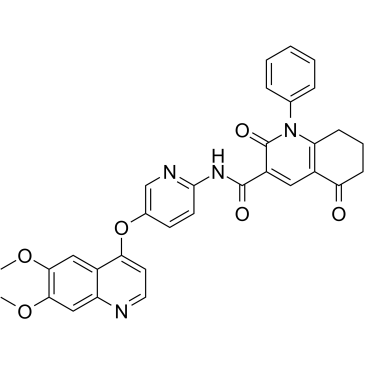| Cas No.: | 1646839-59-9 |
| Chemical Name: | ONO-7475 |
| Synonyms: | ONO-7475,ONO 7475,ONO7475 |
| SMILES: | O=C(NC1C=CC(OC2C3C(=CC(=C(C=3)OC)OC)N=CC=2)=CN=1)C1C(=O)N(C2C=CC=CC=2)C2CCCC(=O)C=2C=1 |
| Formula: | C32H26N4O6 |
| M.Wt: | 562.57 |
| Purity: | >98% |
| Sotrage: | 2 years -20°C Powder, 2 weeks 4°C in DMSO, 6 months -80°C in DMSO |
| Description: | ONO-7475 is a potent, selective, and orally active novel Axl/Mer inhibitor with IC50 values of 0.7 nM and 1.0 nM, respectively. ONO-7475 sensitizes AXL-overexpressing EGFR-mutant NSCLC cells to the EGFR-TKIs, suppresses the emergence and maintenance of tolerant cells. ONO-7475 combines with Osimertinib (HY-15772) provides a bright promise for the study of EGFR-mutated non-small cell lung cancer (NSCLC)[1]. |
| Target: | IC50: 0.7 nM (AXL)[1] IC50: 1.0 nM (MER tyrosine kinase)[2] |
| In Vivo: | ONO-7475 (oral gavage; 10 mg/kg or combines with 5 mg/kg Osimertinib; 29 days) treatment alone has little effect on the tumor growth. Besides, Osimertinib alone causes tumor regression within one week, but the tumors reappear within three weeks. The combined initial treatment causes tumor regression and the size of tumors is maintained for 4 weeks. No apparent adverse events, including weight loss are observed during these treatments[1]. Animal Model: Mouse CDX model using high-AXL-expressing PC-9KGR cells (exon 19 deletion and the exon21-T790M mutation in EGFR)[1] Dosage: 10 mg/kg; once daily; 19 days Administration: oral gavage Result: Had little effects alone, but combined treatments significantly decreased tumor volume without reappear. |
| In Vitro: | ONO-7475 is against recombinant human AXL with IC50 values of 0.414 nM and 0.7 nM in off-chip MSA and ACD cell-based tyrosine kinase assay, respectively. It is against AXL, MER, TYRO3, TRKB, PDGFR alpha, TRKA, and FLT3 activities with IC50 values of 0.7 nM, 1.0 nM, 8.7 nM, 15.8 nM, 28.9 nM, 35.7 nM and 147 nM, respectively in a Cell-based Tyrosine Kinase assay[2]. ONO-7475 (0.0001 μM-1 μM; 72 hours) increases the sensitivity to Osimertinib and Dacomitinib and reduces the viability of high AXL-expressing PC-9 and HCC4011 cells, but not of low-AXL-expressing HCC827 cells. Besides, ONO-7475 enhances Osimertinib efficacy on the viability of cell lines PC-9, PC-9KGR, and HCC4011, and H1975, all of which express high levels of AXL. But it has a marginal effect on the viability of cell lines HCC827, HCC4006, and H3255 with low levels of AXL[1]. ONO-7475 (1 μM; 4 or 48 hours) combines with Osimertinib markedly inhibits the phosphorylation of AXL, AKT, and p70S6K compared with the treatment of the high-AXL-expressing cell lines treated with Osimertinib alone at 4 hours. It combines with osimertinib increases cleaved PARP in PC-9 and HCC4011 cells compared with the treatment with Osimertinib alone[1]. Cell Viability Assay[1] Cell Line: High AXL-expressing cell: PC-9,HCC4011,H1975, PC-9KGR cells Low AXL-expressing cell: HCC827, HCC4006, and H3255 cells Concentration: 0.0001 μM; 0.001 μM; 0.01 μM; 0.1 μM; 1 μM Incubation Time: 72 hours Result: Increased the sensitivity and efficacy to Osimertinib in AXL-high level cells. Western Blot Analysis[1] Cell Line: PC-9, HCC4011 cells Concentration: 1 μM Incubation Time: 4 or 48 hours Result: Increased p-AXL, AKT, and p70S6K expression at 4 hours and increases p-PARP expression at 48 hours when combindes with Osimertinib. |
| References: | [1]. Okura N, et al. ONO-7475, a Novel AXL Inhibitor, Suppresses the Adaptive Resistance to Initial EGFR-TKI Treatment in EGFR-Mutated Non-Small Lung Cancer.Clin Cancer Res. 2020 Jan 17. [2]. Ruvolo PP, et al. Anexelekto/MER tyrosine kinase inhibitor ONO-7475 arrests growth and kills FMS-like tyrosine kinase 3-internal tandem duplication mutant acute myeloid leukemia cells by diverse mechanisms.Haematologica. 2017 Dec;102(12):2048-2057. |

 To enhance service speed and avoid tariff delays, we've opened a US warehouse. All US orders ship directly from our US facility.
To enhance service speed and avoid tariff delays, we've opened a US warehouse. All US orders ship directly from our US facility.




















